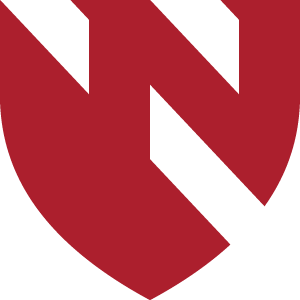TravelSmart receives Regional Service Award from MAPA
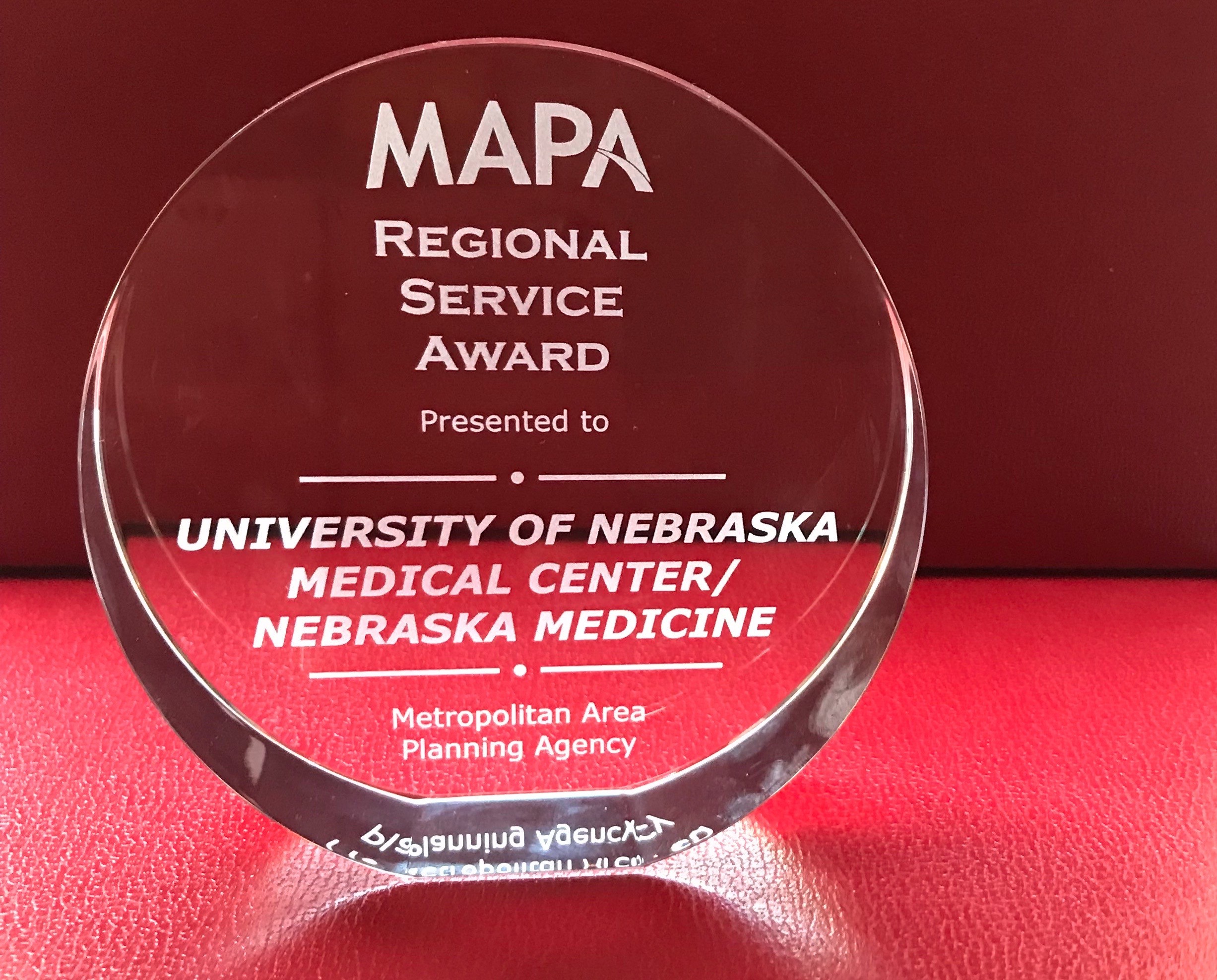
Last week, TravelSmart was honored by the Metropolitan Area Planning Agency (MAPA) with the Regional Service Award.
MAPA is a regional Council of Governments serving Eastern Nebraska and Western Iowa. MAPA brings local and regional officials together with citizens like you to connect, plan and thrive.
We were honored to receive the Regional Service Award, given to “an organization whose efforts have had an extraordinarily positive influence on the MAPA five-county region.”
Specifically, UNMC and Nebraska Medicine were honored for “its work to create an innovative and sustainable solution to transportation challenges in the Omaha Metro area” and for “standing out as a regional leader.”
TravelSmart is currently reducing a parking garage worth of cars (~700) coming to campus each day, which reduces emissions, promotes healthier lifestyles, saves participants money, and reduces traffic congestion which further reduces emissions, road use (repair), and leading to safer and healthier environment for the campus and Greater Omaha region.
Representing the med center at the event were (from left to right in the picture) Mike McGlade (transportation and parking committee chair, senior associate dean of administration COM), Hannah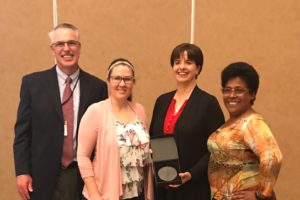 Stanzel (clinical services associate for MMI, former parking assistant who helped implement TravelSmart), Melanie Stewart (sustainability manager for Nebraska Medicine and UNMC), and Tina Spencer (specialist, former parking manager who helped implement TravelSmart). Not pictured, Daniel Lawse, Verdis principle who helped design and implement TravelSmart.
Stanzel (clinical services associate for MMI, former parking assistant who helped implement TravelSmart), Melanie Stewart (sustainability manager for Nebraska Medicine and UNMC), and Tina Spencer (specialist, former parking manager who helped implement TravelSmart). Not pictured, Daniel Lawse, Verdis principle who helped design and implement TravelSmart.
TravelSmart was also selected by the Heartland 2050 Initiative to be the featured example in their recent “Closing the Gap” which demonstrated how complete active transportation programs can help both businesses and participants (see above) but can also help attract and retain talent in the workforce.
Are you already a TravelSmartie? That’s great! Don’t forget to contact travelsmart@unmc.edu if you need anything.
Considering TravelSmart? It’s a great way to save money, reduce emissions/pollutants, and most of the time, increase your physical activity. Want to save a little money (holidays are right around the corner) it’s all FREE and a great way to reduce your costs. You don’t have to give up your parking permit and you don’t have to use it for every commute. Check out the TravelSmart website for more details or contact travelsmart@unmc.edu We are happy to answer any questions or concerns, help you find a bus route or park and ride location, and we can even assist in finding a carpool partner.
Recycle Right
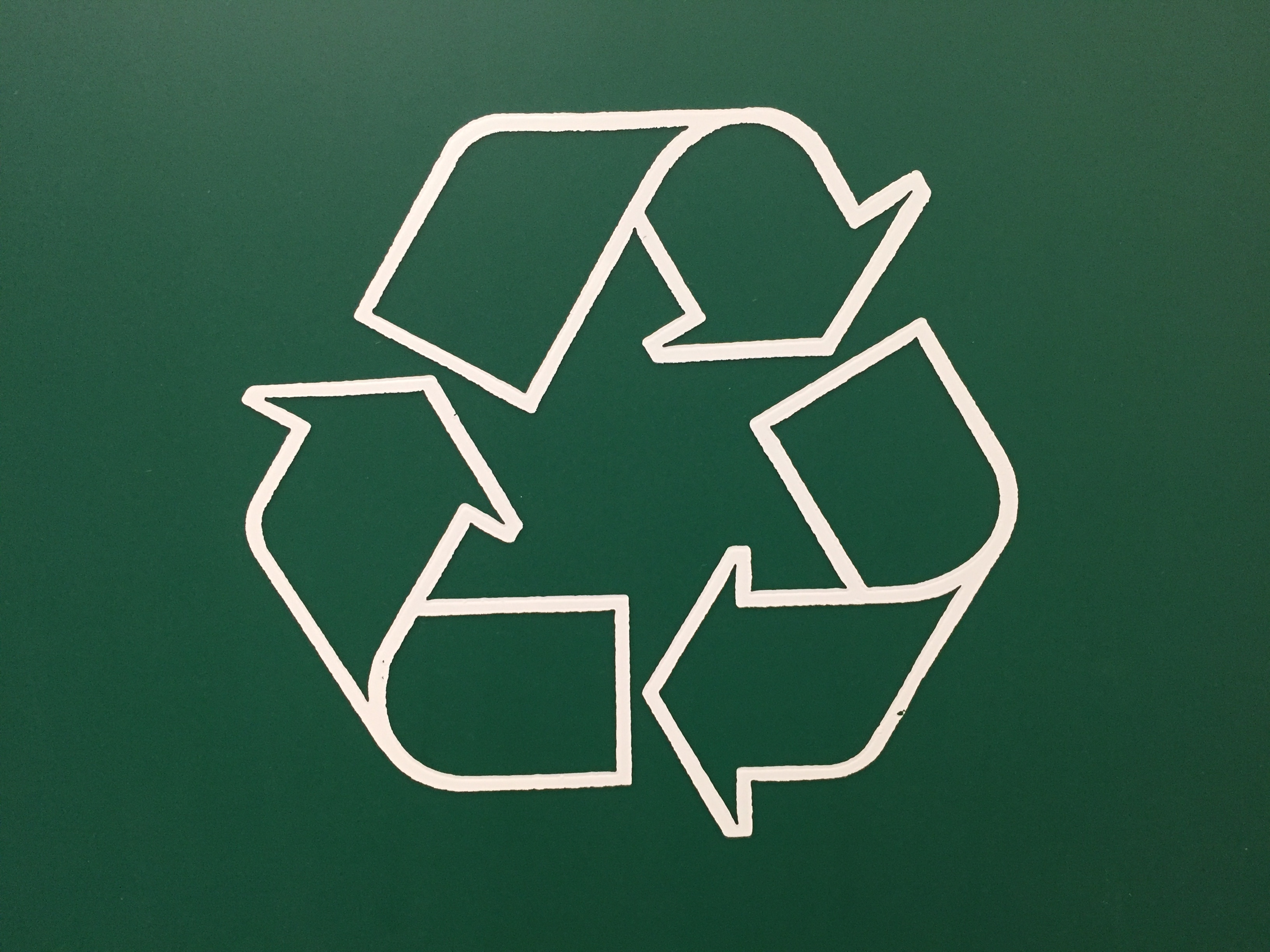
By Melanie Stewart
UNMC and Nebraska Medicine have a goal to divert 90% of our waste from the landfill by 2030. One of the easiest actions for all individuals to take is recycling an item once it can no longer be used.
We currently recycle 26% of our waste; this is an improvement on our baseline, but we still have a ways to go. Unfortunately for us, China has decided to be more selective on the waste/recycling they take from other countries. While very little recycling from Omaha ends up there, this change has created a domino effect that does impact us. The change that is the most important to note is contamination. If recycling streams contain too much contamination the entire load will be sent to the landfill. Contamination can occur in 2 ways; having trash/recyclables in the wrong stream (pop can in the paper container, or potato chip bag in the plastic container) or trash mixed in with recycling. This is most common is food/drink still in the item.
Do I need to wash my recyclables before placing in a bin? In short, no. Beverage containers need to have the liquids emptied, but they don’t need to be rinsed/washed. Food needs to be removed and soiled items (greasy pizza box, etc.) should be placed in the trash. Containers don’t need to be washed, just get the bulk of the food/sauce out. E.g. eat all the yogurt, no need to clean, or use your napkin to dump the lasagna you didn’t eat into the trash, no reason to wash it.
We’ve made good progress, but have work to do.
Remember the basics:
- Paper: Put mixed paper in the blue bins. Virtually all paper products on campus can be recycled: copy paper, envelopes (including plastic windows), scratch paper, glossy paper, construction paper, clean food packaging, newspaper, receipts, post-its, notebook paper.
- Cardboard: All Corrugated cardboard (boxes used for shipping) and standard cardboard (sometimes referred to as paperboard: facial tissue/cereal/frozen meal boxes) can be recycled on campus. Please break all boxes down flat and place them between your paper recycling bin and the wall or at the designated location for your building.
- Metal: Metal should be placed in the green bins, along with plastics. These materials include aluminum (pop) and tin (soup) cans, but small metal shipping containers and other metals can be recycled too.
- Plastic: Plastic is recycled in the same container as metal. All plastics that go in the green bins need to be rigid. Any items that holds shape on its own can be recycled, i.e. bottles, frozen meal trays, plastic dinnerware, yogurt cups, lids, straws, can all be recycled. Soft plastics like plastic bags, plastic wrap, bubble wrap, cellophane cannot.
Other items can be recycled at the Med Center; including aerosol cans, furniture, electronics and toner cartridges. For more information see the LiveGreen Recycling page.
Thank you for helping us get to our Zero Waste goal!
Fall EcoChallenge
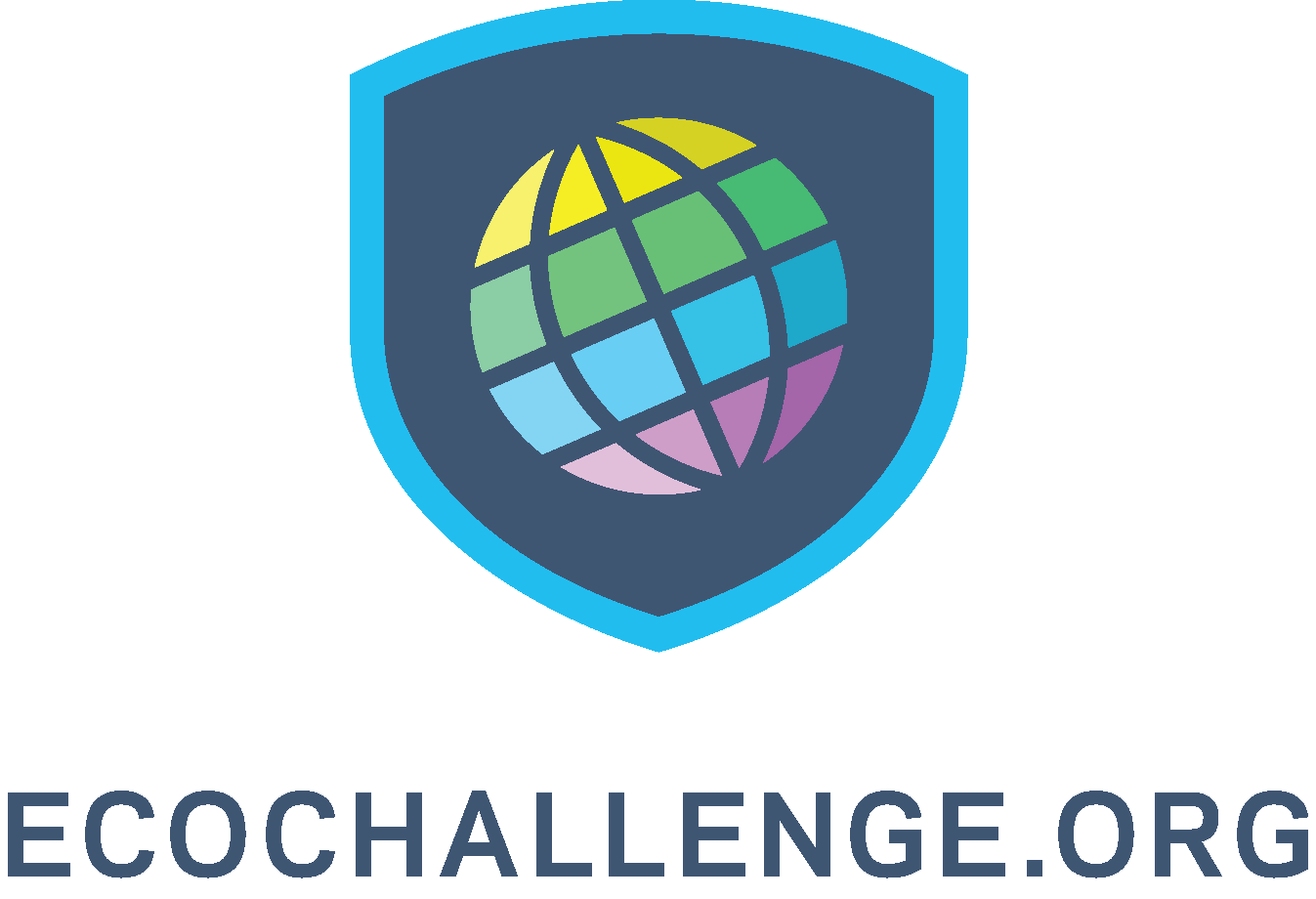
October is campus sustainability month and there is a new EcoChallenge, though similar in style to the one this spring. This EcoChallenge has new categories (including health!) to choose from and new actions within all the categories, so there is something for everyone, including family members and kids.
You may recall the Drawdown EcoChallenge that we participated in April during earth month; we combined the Med Center team with the team from UNO and we rocked it! Based on our points we were 40th in the nation, out of 767 teams!
We participate because the EcoChallenge is designed to be fun but also to take measurable action on topics that you care about. While you earn points, you also get to see how these three weeks of learning and/or actions add up to make meaningful change—in our community and around the world.
Join our team! It’s a fun way to learn about a variety of sustainability topics both locally and worldwide and more fully understand the impact of choices we make, but also available solutions. If you have friends or family members that want to join our team, we’d loved to have them as well.
New this fall: we challenged the UNO team to a friendly competition for bragging rights! And did I mention the health category?
Ready to join our team?
You can sign up for free, track/share progress online and earn points. Points help us to compete against UNO and earn you prizes. You can select as many actions as you want, ranging from replacing a bulb with a LED, to watching a video, using mass transit, or pledging to spend a specific amount of time learning about a topic. You can pick whatever interests you as there are numerous options to pick from in 9 different categories:
- Health
- Waste
- Food
- Transportation
- Energy
- Community
- Nature
- Water
- Simplicity
- or Create your own
So what are you waiting for? Join our team today to turn intention into action; all while having fun and winning prizes—oh, and having a positive impact on the planet and humanity.
Alkaline Battery Recycling Help
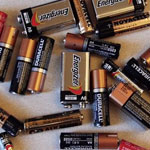
As you may know, the Med Center recycles single use alkaline batteries. We provide a repurposed gallon container, you fill it, and we recycle it. It’s like magic. Alright, it’s not magic, it’s many of you taking the time to recycle batteries along with some special people behind the scenes that make that happen.
People have been a little lax on compliance, making this process downright un-magical, and threatening its existence.
Please:
- Only single use alkaline batteries can go into these containers.
- Rechargeable, lithium/nickel ion, watch/button batteries and light bulbs are considered universal waste and must be handled separately. The same online form can be used, but they must be in a separate container.
- If a battery has acid buildup or corrosion, please place it in a small plastic bag prior to placing it in the container. Movement makes this a dust, exposing our personnel, and no one wants to breath that in.
- Only batteries used at the Med Center can go in.
- Batteries from home or personal devices cannot be recycled here. You can contact your local Batteries Plus store as they may recycle them, or hold them until Earth Month.
- If you have large quantities you can have multiple containers. However, you should still fill out the form when you have an empty one so you can continue to recycle them while waiting for pickup. EHS has to pick up regulated waste first and while they do their best, it may be several days before they get to you. Indicate on the form how many containers need to be picked up/replaced.
- If you are in an area where multiple people ‘manage’ a battery container, please place a note on the lid to indicate the pickup has been requested to avoid multiple requests.
Easy, right? Please make sure people in your area know these rules so we can continue to keep these chemicals out of the landfill and local waterways.
If you don’t currently have a container but want to recycle batteries, check with your neighbors, there is likely one close by. If you do need one, use the on-line form to request one. Make sure your building and room are listed and mention that you do not need a container picked up, just an empty one.
Not located at the 42nd and Dewey campus but still want to recycle batteries? Email LiveGreen@unmc.edu and we’ll help you.
UNMC BBQ is Campus’s First Zero-Waste Event
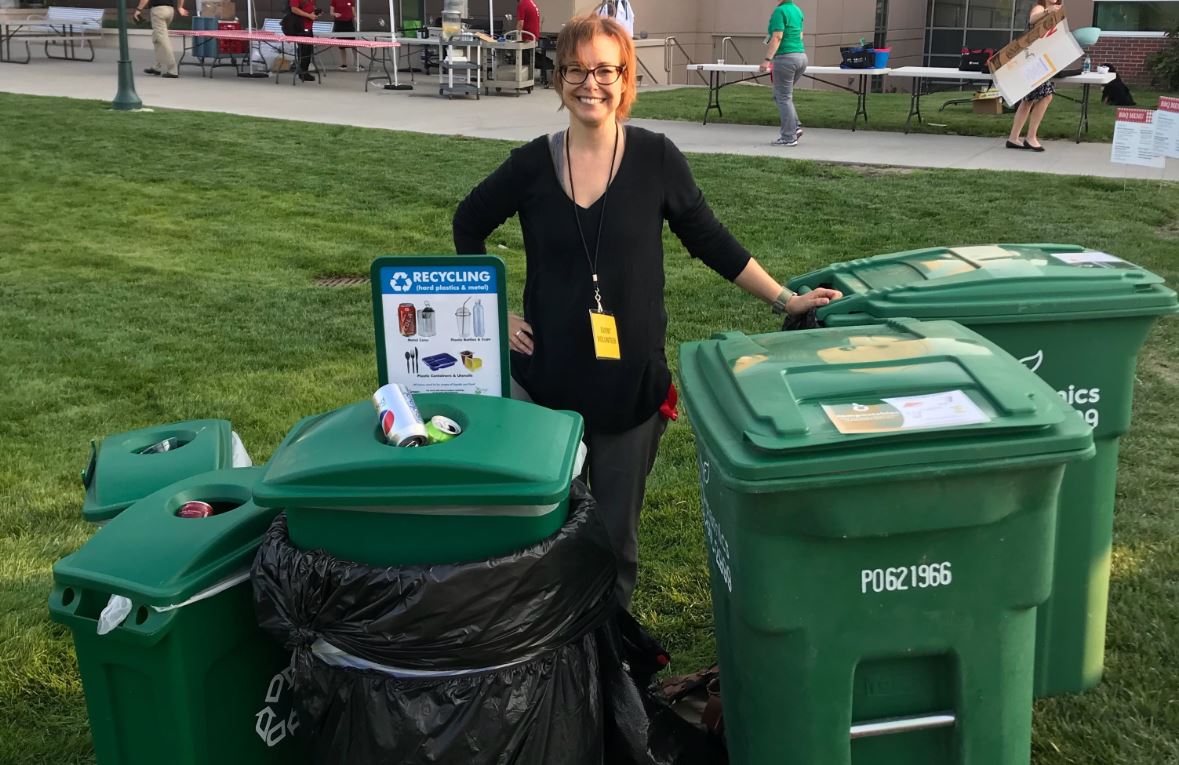
As you hopefully knew, the UNMC BBQ was held in the MSC plaza less than 2 weeks ago. It was a beautiful day with hundreds of people showing up to play games, eat good (free!) food, find information on campus opportunities, and receive free items. There was even a fun Zumba demonstration!
It was also the campus’s first Zero Waste Event.
So what is a Zero Waste event?
A Zero Waste event means that 90% of all the waste generated in prep for and at the event will be diverted from the landfill, generally by recycling and composting. While technically not ZERO waste, the 10% allows for things that are unavoidable—this is often plastic wrap that protects unprepared food (uncooked meat), etc. that planners cannot control and/or improper sorting by attendees. We can control the types of food served and can work to keep that waste to a minimum. We can also control the items given to the end user to make sure the can be composted or recycled.
A special thanks to the LiveGreen Volunteers who stood at the waste stations and made sure attendees got the right items in the right place. If you see Vicki Cerino, Ashley Ryan, Chrystal Nathan, Jessie Horst, Tricia Saxton, Victoria Smith, Kimberly Norman, Debbie Vidlak, Theresa Pikschus, and/or Darren Dageforde, please thank them, they made this happen! Don’t forget to thank the planning committee and Sodexo too.
So how did we do? 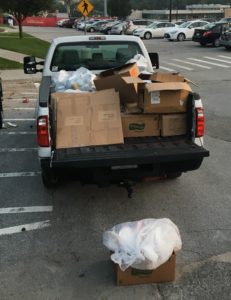
Meals Served: 918
Compost: 289lbs
Mixed plastics & metal recycling: 81.4lbs
Cardboard recycling: 37lbs
EnergyBag/soft plastics: 17.8lbs
Landfill: 17.4lbs
Total: 96.07% diverted from the landfill
Impressive! More than 900 meals and only 17lbs of trash! That comes out to 0.02lbs per person and has us easily diverting the 90% required.
The picture at the side gives you an idea; the box on the ground is the only trash created and the back of the pickup is all recycling. This does not count the 5 totes completely full of future compost.
Can you host a zero waste event? Maybe a departmental meeting or even a meal at home? Even if you are not 100% successful, you may start to notice ways to reduce your waste, and save you money. If you have successes or tips you think other people should know about, please comment on this post.
Party Food

Last week we talked about easy actions you can take to save money and reduce waste when hosting, or attending, a party—whether that’s a picnic, sports party/tailgate, or fall get together.
We didn’t get to food last week. Food is often the center of parties but it can also have the biggest impact in terms of sustainability. It’s easy to forget how many resources go into providing the food we eat, and the impact that has on the environment around us.
Did you know it takes more than 1,000 gallons of water to produce 1lb of beef? Have you thought about the gallons of gas needed to transport your food from farm to production plant to warehouse to grocery store to your house?—and that doesn’t include planting, fertilizing, harvesting, and storing crops, and potentially feeding to livestock.
Don’t stop reading, this isn’t a lecture. Just know that making some conscious decisions can lessen your impact, save you money, and you can still put out a great spread:
- Buy local. Find locally grown produce at Farmer’s Markets, CSAs, and at some grocery stores. By local meat direct from farmers/butcher shops, and buns from local bakeries. Your food will taste better, have a better nutritional content, and you’ll support your local economy.
- Dare I say, go meatless? Production of meat uses a lot of natural resources–farmers have to grow food that could to go humans to feed the animal that humans later eat.
- Grill with propane. It has a lower level of emissions and fewer VOCs than charcoal. Can’t possibly use gas? Go for sustainably sourced natural brands of charcoal; fewer chemicals go into your food – better for your health, your family, and for the planet.
- Buy locally brewed beer or organic beer. Many brewers reuse/refill glass bottles, take advantage.
- Skip prepackaged foods. They are almost always less healthy, cost more, and have more packaging. Make the foods you love and then only make what you will eat—use the “guest-imator” if you need help planning.
Did you make too much food? If it won’t be eaten as leftovers (be honest with yourself!) don’t toss it or store it until it grows mold, rescue it! Did you know there a multiple locations that will accept prepared food to serve those in need? Saving Grace will pick up larger quantities (wedding receptions, etc.) and get them to the right place.
Picnics, Tailgates and Parties, oh my!

If you are a sports fan, you are probably excited for fall. College football fever is at an all-time high in Nebraska, fantasy draft parties are taking place, and baseball fans can smell October. If you aren’t a sports fan, I’m willing to bet you have a Labor Day party, family picnic, or a Halloween/fall party to host or attend.
All of those parties means lots of people, food, and waste.
So what can you do to reduce that impact and save you money? LiveGreen has easy tips for you in this 2-part article, no lifestyle change required.
Let’s start with party prep.
Use reusable tableware, utensils, and serving dishes. Yes, they are a little more expensive, but they’ll pay for themselves after a few parties. Don’t forget your friends! They’ll likely let you borrow serving dishes or other necessities. Most will be dishwasher safe, making cleanup easy. If reusable tableware isn’t an option, buy recyclable items made with recycled material. Strive for plastics labeled #1 & #2, as they are more easily recycled.
If you are using materials that are recyclable, make sure they get recycled! Have easily accessible bins, label them to make it easy for guests, and always have trash and recycle bins next to each other. Consider using “Energy Bags” for soft plastics. If you are in a park or at a tailgate, take those recyclables home, and whatever you do, don’t litter.
To decorate, use things you already have—memorabilia, blankets, even old apparel. Go back to those friends and borrow this from them too. You can do the same for their next party and everybody wins. If you must buy new, look for things that will last a long time so you don’t have to purchase them again and look for items made of recyclable material. Have old apparel you don’t wear but can’t give up? Use them to make reusable napkins, tablecloths, or other decorations.
Whenever possible, buy in bulk. Larger quantities of the items you know you will need will ultimately save you money and reduce the amount of waste created. One family size bag of chips is less packaging than 2 small ones and a case of pop is less packaging than two 12-packs. Items like this store all season long and save you trips to the store. Remember to take reusable bags whenever you shop.
Next week: food!
photo credit: wikimediacommons
As Heat Returns, Energy Curtailment is On

After a few weeks of seasonable to below-average temperatures the heat is returning, which means energy curtailment will too.
That heat and humidity puts extra stress on our systems as these curtailment days are our highest energy-users. Energy curtailment allows us to control our maximum energy demand or “peak”. If we can reduce energy where it isn’t needed, we ensure that everything that needs energy is getting it. Lower energy means lower emissions, better air quality, and better health for our community–our mission. It also saves us money as our utility rates are based on peak use. The maximum of energy we use at any given time determines the rate we pay for the entire next year. I can think of many other things to spend money on, can’t you?
Energy Curtailment can be confusing though. Spaces may actually be colder than your chosen set-point and/or in the afternoon the temperature may rise above it. It’s sounds crazy, but both manners can help to save energy. It’s not true at your house but is true here, because of the requirements for patient-care and research spaces. Please see our website for further explanation.
We still need your help! When the outside temperature becomes unbearable, we’ll ask you to help ease the energy load by performing simple actions.
Need to see your colleagues have fun demonstrating these actions? Watch this:
Or you can just read this:
- close shades, blinds and curtains whenever possible to reduce solar heat gain;
- lower lighting levels where possible, turn off lights in unoccupied areas and when leaving a room;
- shut fume hood sashes when not in use;
- take the stairs instead of the elevator (leave them for those that need them);
- turn off and unplug all electrical equipment not in use (computers, coffee makers, printers, chargers, etc.);
- open doors manually instead of using the ADA buttons;
- use revolving doors whenever possible;
- don’t charge items on campus, wait until after 7pm unless absolutely necessary;
AND
- Tell other people so they can help too!
These easy steps combine to have a huge impact, on the hot days and for the year ahead. We know not being able to control your space isn’t optional and appreciate your cooperation in this endeavor. Thank you for helping to improve health, reduce pollution, and save money.
Travel Sustainably

by Treyten Ozuna
Traveling has been shown to increase levels of happiness, boost creativity, and decrease stress. Seeing the world allows a person to experience new ideas, cultures, and people, but traveling and tourism can have negative impacts on the places we’re visiting.
If you aren’t following our staycation guide this summer, here are three big ways to travel responsibly this vacation season:
Transportation
Sometimes traveling by plane is the only option for reaching a long-distance destination. Unfortunately, the aviation industry represents the transportation sector with the fastest growing greenhouse gas emissions. With air quality being the leading environmental threat to public health, it’s important we make responsible decisions regarding our mode of transportation.
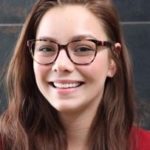
To travel more sustainably, seek out airlines that offer carbon offset programs or use biofuels. Always keep airtime minimal and opt for non-stop flights wherever possible.
If you’re traveling a short distance, you may even consider traveling by train. You’re able to sight see along the way and you’d be reducing your carbon footprint by half.
If you’re sorting out how to get around once you arrive, opt for electric vehicles or public transportation.
Accommodations
Booking through home-sharing services supports a more efficient use of existing resources. One study showed that staying in an Airbnb is actually more sustainable than even the most energy-efficient hotels. Next time you’re looking for accommodations, give services like Airbnb, Couchsurfer, or other shared services a try. Staying with locals or meeting fellow travelers could certainly add to your experience.
Community
Our actions impact the communities we’re visiting. The World Tourism Organization reports that out of each $100 spent during a trip, only $5 benefits the destination.
Be mindful of your economic contribution. Support businesses and services that contribute to the local economy and preserve the cultural heritage of the community. You’ll likely find an artisan made souvenir or dinner at a local family restaurant is more memorable.
It’s also important to also be weary of purchasing wildlife products as they can inadvertently support the market for trafficking rare and endangered wildlife products.
Traveling can be a fulfilling experience and improve the quality of your life. Sustainability doesn’t have to be more expensive or a drag, it can enhance your vacation experience. It’s possible to the keep public health, the environment, and community in mind, and still have the time of your life.
photo credit: freeimages.com/lisalangell
American Medical Association Takes a Stand

The American Medical Association (AMA) is one of the most well-known and respected medical organizations in the country, having been established in 1847 and publishing the Journal of the American Medical Association (JAMA).
At their annual meeting in June, the AMA joined the World Medical Association, British Medical Association, and Canadian Medical Association in the decision to completely divest from fossil fuels. The resolution will “end all financial investments or relationships with companies that generate the majority of their income from the exploration for, production of, transportation of, or sale of fossil fuels”. This is quite a statement, given that fossil fuel companies continue to be profitable. The AMA’s choice is about health and care of patients, not money.
In their public statement, they were very clear: “It is meaningful that the American Medical Association…is saying to the dirty fuels industry now just what it said to tobacco a generation ago: You are killing our patients and we will not allow it anymore” said Todd Sack, MD, who co-authored the resolution.
Did you know air pollution from fossil fuels causes 200,000 premature deaths each year in the United States alone? Or that closing coal and oil plants immediately lowers the risk of pre-term births in surrounding areas? Carbon pollution from fossil fuels is also the leading cause of climate change, which contributes to an increase in many public health concerns including but not limited to: vector-borne diseases, food and water scarcity and contamination, migration, and heat-related illnesses.
This resolution also calls for the AMA to choose vendors, suppliers, and corporations that have demonstrated environmental sustainability practices that seek to minimize their fossil fuels consumption. It also intends to support physicians/health professional associations with policy analyses, education, and informing patient/public/government policy makers.
This is why Nebraska Medicine and UNMC have made a strong commitment to sustainability, pledging to by 2030:
- Become carbon neutral (net zero building emissions)
- Achieve zero waste (90% of all non-biohazardous materials leaving campus will be diverted from the landfill and incineration)
- Use less water than what falls on the main campus during an average rainfall year (54% reduction)
- Increase the trips made to campus using active transportation to 35%
It’s about health. It’s preventative healthcare. It’s our mission. We will lead the world in transforming lives to create a healthy future for all individuals and communities.
To learn more about our goals and their impacts, click here.
photo credit: freeimages.com/nikitagolovanov
